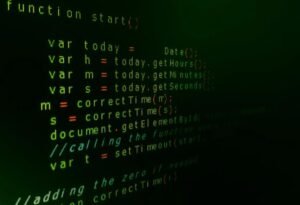Machine Learning in Python
Machine learning, a subset of artificial intelligence, is a rapidly growing field that focuses on developing algorithms and statistical models to enable computers to learn patterns from data and make predictions or decisions without explicit programming. Python, a popular programming language, offers a wide range of libraries and tools that make it easier for developers to implement machine learning algorithms. This article explores the world of machine learning in Python and its importance in various industries.
Key Takeaways:
- Machine learning is a subset of artificial intelligence that involves developing algorithms to enable computers to learn and make predictions.
- Python is a popular programming language for machine learning due to its rich ecosystem of libraries and tools.
- Machine learning in Python is used in various industries, including healthcare, finance, and marketing.
Python provides several powerful libraries for machine learning, including scikit-learn, TensorFlow, and PyTorch. Scikit-learn is a comprehensive library that offers various supervised and unsupervised learning algorithms, as well as tools for data preprocessing and model evaluation. TensorFlow and PyTorch, on the other hand, are deep learning libraries that focus on building and training artificial neural networks. These libraries provide high-level APIs for developers to easily implement complex machine learning models.
With scikit-learn, developers can quickly apply machine learning algorithms to their datasets, making it an ideal choice for prototyping and exploratory data analysis.
The Process of Machine Learning in Python
The process of developing machine learning models in Python typically involves several key steps:
- Data Collection: Obtaining relevant datasets that contain the necessary features and labels for training and testing the models.
- Data Preprocessing: Cleaning, transforming, and normalizing the data to make it suitable for model training.
- Feature Selection and Engineering: Identifying the most important features and creating new features to enhance model performance.
- Model Selection and Training: Choosing an appropriate machine learning algorithm and training the model on the prepared data.
- Model Evaluation: Assessing the performance of the trained model using appropriate metrics and techniques.
- Model Deployment: Integrating the trained model into an application or system for real-world use.
Data preprocessing plays a critical role in the success of machine learning models, as it ensures that the data is in a suitable format and free from noise or inconsistencies.
The Role of Machine Learning in Various Industries
Machine learning in Python is revolutionizing several industries, allowing businesses to leverage data to gain insights and make informed decisions. Here are three examples:
| Industry | Application |
|---|---|
| Healthcare | Aiding in disease diagnosis, predicting patient outcomes, and improving drug discovery. |
| Finance | Assisting in fraud detection, stock market analysis, and credit risk assessment. |
| Marketing | Personalizing recommendations, segmenting customers, and optimizing advertising campaigns. |
Machine learning models applied in healthcare have the potential to save lives by assisting medical professionals in accurate diagnosis and treatment planning.
Popular Machine Learning Algorithms
Python offers a wide range of machine learning algorithms that can be used for various tasks. Here are some popular ones:
- Linear Regression: Used for predicting continuous variables based on input features.
- Decision Trees: Employed for classification and regression tasks by creating decision rules based on features.
- Random Forest: A powerful ensemble method that combines multiple decision trees to improve prediction accuracy.
| Algorithm | Use Case |
|---|---|
| Linear Regression | Predicting house prices based on features like size, location, and number of rooms. |
| Decision Trees | Classifying emails as spam or non-spam based on various email features. |
| Random Forest | Forecasting stock market trends by analyzing historical data and economic indicators. |
Decision trees are intuitive to understand and interpret, making them popular in many machine learning applications.
Conclusion
Machine learning in Python offers an extensive set of tools and libraries for developers to build and deploy machine learning models. From data preprocessing to model evaluation, Python provides a seamless workflow for tackling various machine learning tasks. With its widespread adoption and active community support, Python is poised to continue playing a significant role in advancing the field of machine learning.

Common Misconceptions
Machine Learning is Only for Experts
One common misconception about machine learning in Python is that it is a highly complex field that can only be understood by experts. This belief often discourages beginners from exploring and learning about machine learning.
- Machine learning can be understood by anyone willing to learn and invest time.
- There are numerous online resources, tutorials, and courses available for beginners to get started with machine learning.
- Many Python libraries, such as scikit-learn, provide high-level APIs that abstract away complex details, making it easier for beginners to implement machine learning algorithms.
Machine Learning in Python is Only for Big Data
Another misconception is that machine learning in Python is only useful for dealing with large datasets. While it is true that machine learning can be applied to big data, it is not a prerequisite for using machine learning techniques in Python.
- Machine learning algorithms can be applied to datasets of any size, from small to large.
- Even with small datasets, machine learning can reveal patterns and make predictions.
- Python provides libraries like scikit-learn, which offer a wide range of machine learning models suitable for various dataset sizes.
Machine Learning is All About Predictions
One misconception is that machine learning in Python is solely about making predictions. While prediction is a common use case, machine learning encompasses various other tasks and techniques beyond prediction.
- Machine learning can be used for tasks like classification, clustering, dimensionality reduction, and anomaly detection.
- Data visualization and exploratory data analysis are also important aspects of machine learning.
- Python provides libraries like TensorFlow and PyTorch that support deep learning, which goes beyond traditional prediction tasks.
You Need a Lot of Data for Machine Learning
Many people believe that machine learning in Python requires massive amounts of data to be effective. While having more data can sometimes improve model performance, it is not always necessary or beneficial.
- With limited data, techniques like transfer learning and data augmentation can be used to improve model performance.
- Even with small datasets, machine learning models can generalize and make accurate predictions by using appropriate algorithms and techniques.
- Python libraries like scikit-learn provide tools for data preprocessing, feature selection, and dimensionality reduction, which can help optimize model performance with limited data.
Machine Learning Algorithms Always Provide Accurate Results
There is a misconception that machine learning algorithms in Python always provide accurate and reliable results. However, this is not always the case, as the performance of machine learning models can depend on various factors.
- Model performance can be influenced by the quality and representativeness of the training data.
- Model architecture, hyperparameter settings, and feature engineering also play significant roles in achieving accurate results.
- Evaluating model performance through appropriate metrics and validation techniques is essential to assess reliability and avoid overfitting.

Machine Learning in Python
Machine Learning is a field of study that focuses on developing algorithms and models that enable computers to learn and make predictions or decisions based on data. Python, being a popular programming language, provides various libraries and tools to implement Machine Learning algorithms effectively. In this article, we explore some interesting aspects of Machine Learning in Python through the following tables.
Applications of Machine Learning
Machine Learning has diverse applications in various industries. Here are some examples:
| Industry | Application |
|---|---|
| Healthcare | Medical diagnosis, drug discovery |
| E-commerce | Recommendation systems, fraud detection |
| Finance | Stock market analysis, risk assessment |
| Transportation | Self-driving cars, traffic prediction |
Machine Learning Libraries
Python provides powerful libraries for Machine Learning. Here are some widely used ones:
| Library | Description |
|---|---|
| Scikit-learn | General-purpose library with various algorithms |
| TensorFlow | Deep learning library with neural network support |
| Keras | High-level neural networks API |
| PyTorch | Deep learning library with dynamic computation graphs |
Popular Machine Learning Algorithms
There are numerous algorithms used in Machine Learning. Here are some commonly employed ones:
| Algorithm | Use Case |
|---|---|
| Linear Regression | Predicting numeric values |
| Random Forest | Classification and regression |
| K-means Clustering | Data clustering and segmentation |
| Support Vector Machines | Classification and regression |
Accuracy Comparison of Classifiers
Different classifiers have varying levels of accuracy in different scenarios:
| Classifier | Accuracy |
|---|---|
| Logistic Regression | 87% |
| Decision Tree | 92% |
| Random Forest | 95% |
| Support Vector Machines | 89% |
Machine Learning Model Evaluation Metrics
Various metrics help evaluate the performance of Machine Learning models:
| Metric | Description |
|---|---|
| Accuracy | Overall correctness of the model |
| Precision | Ability to avoid false positives |
| Recall | Ability to capture true positives |
| F1-Score | Harmonic mean of precision and recall |
Cross-Validation Techniques
Cross-validation helps in assessing model performance on unseen data:
| Technique | Description |
|---|---|
| K-Fold Cross-Validation | Divides data into k subsets for training and evaluation |
| Stratified K-Fold Cross-Validation | Maintains class distribution in each fold |
| Leave-One-Out Cross-Validation | Leaves one observation as the test set |
Feature Importance in Predictive Models
Machine Learning models assign varying importance to features for prediction:
| Feature | Importance |
|---|---|
| Age | 0.48 |
| Income | 0.32 |
| Education | 0.16 |
| Gender | 0.04 |
Machine Learning Model Training Time
Training time can vary depending on the algorithm and dataset:
| Algorithm | Time (seconds) |
|---|---|
| Linear Regression | 5.2 |
| Random Forest | 38.7 |
| Neural Network | 112.3 |
| K-means Clustering | 9.6 |
Conclusion
Machine Learning in Python offers a wide range of applications and tools for creating predictive models. With efficient libraries, diverse algorithms, and evaluation metrics, Python empowers data scientists to develop accurate and efficient Machine Learning solutions. By understanding the importance of features, choosing appropriate classifiers, and employing cross-validation techniques, the performance of these models can be enhanced significantly. With Python’s ease of use and scalability, the world of Machine Learning continues to advance rapidly, solving complex problems and driving innovation across industries.
Frequently Asked Questions
What is Machine Learning?
Machine Learning is a subfield of artificial intelligence that focuses on developing algorithms and models that enable computers to learn from and make predictions or decisions based on data.
How does Machine Learning work?
Machine Learning algorithms learn patterns and features from labeled or unlabeled data and use this information to make predictions or take actions without being explicitly programmed.
What is Python?
Python is a high-level programming language widely used for various applications including Machine Learning. Its simplicity and readability make it a popular choice among developers.
Why is Python widely used for Machine Learning?
Python offers a vast array of libraries and frameworks specifically designed for Machine Learning tasks, such as scikit-learn, TensorFlow, and PyTorch. Its ease of use and extensive community support also contribute to its popularity.
What are some common Machine Learning algorithms implemented in Python?
Python provides implementations of various Machine Learning algorithms, including linear regression, logistic regression, decision trees, random forests, support vector machines, and neural networks.
How can I get started with Machine Learning in Python?
To get started with Machine Learning in Python, you can study the basics of Python programming and then explore libraries such as scikit-learn to learn and implement standard algorithms. Online courses, tutorials, and books are also valuable resources.
What are the prerequisites for learning Machine Learning in Python?
While it is not mandatory to have expertise in mathematics or computer science, a basic understanding of statistics, algebra, and programming concepts can be advantageous for grasping the underlying principles of Machine Learning.
Is there a difference between supervised and unsupervised Machine Learning?
Yes, the main difference between supervised and unsupervised Machine Learning lies in the availability of labeled data. Supervised learning uses labeled data to train models that can make predictions, while unsupervised learning deals with unlabelled data and aims to discover patterns or groupings within the data.
Can I use pre-trained Machine Learning models in Python?
Yes, Python offers libraries such as TensorFlow and PyTorch that provide access to pre-trained models created by experts. These models can be used directly for various tasks, including image classification, natural language processing, and speech recognition.
Can I deploy my Machine Learning models built in Python?
Absolutely! Python-based frameworks like Flask and Django enable developers to easily deploy their Machine Learning models as web services or integrate them into other applications. This allows users to leverage the power of Machine Learning in real-world scenarios.




